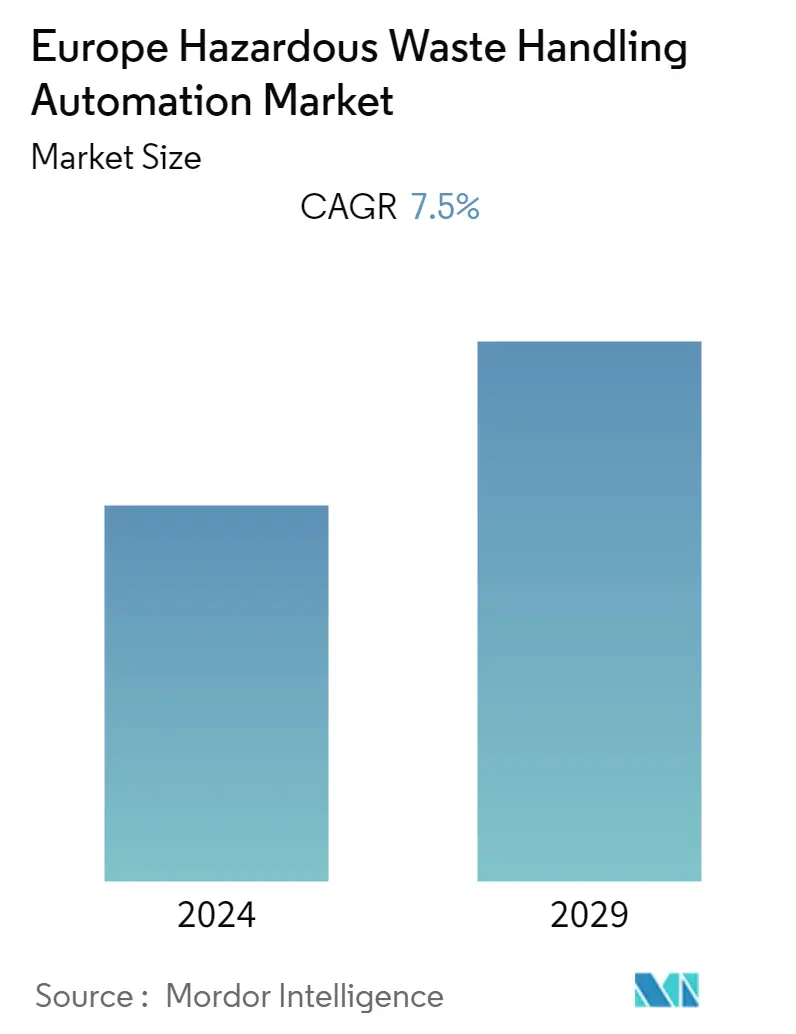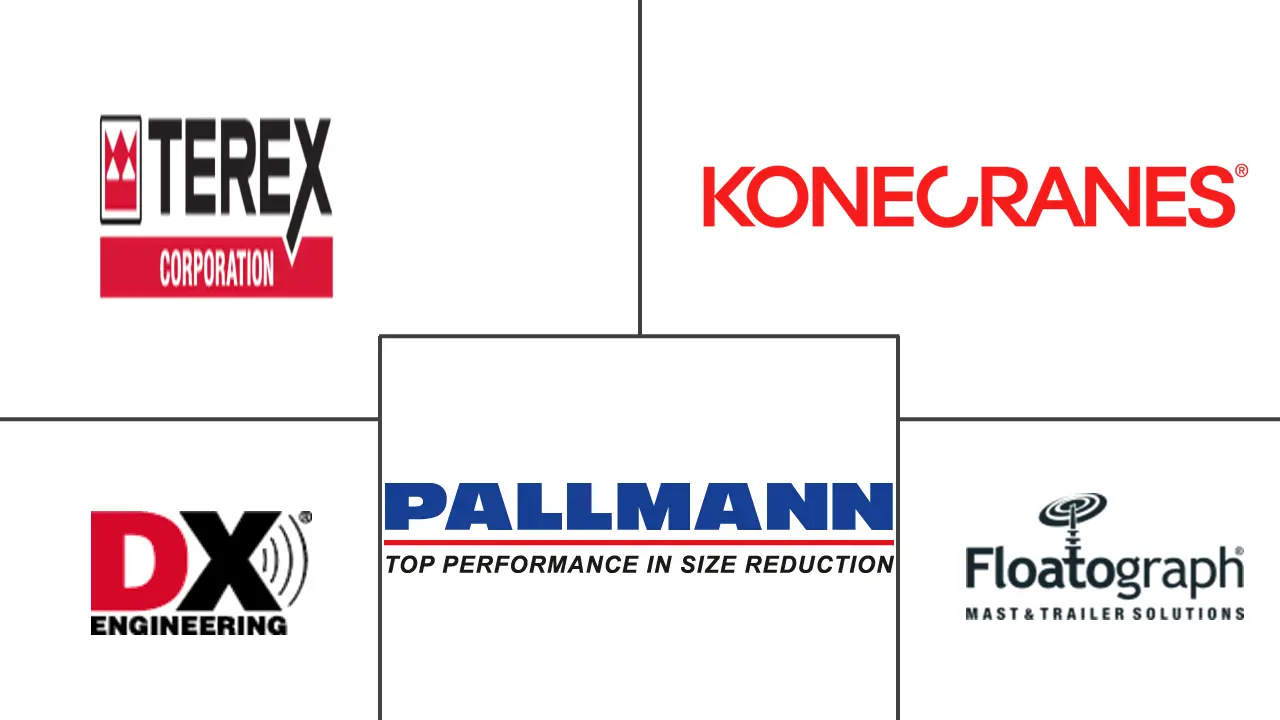Market Size of Europe Hazardous Waste Handling Automation Industry

| Study Period | 2019 - 2029 |
| Base Year For Estimation | 2023 |
| Forecast Data Period | 2024 - 2029 |
| Historical Data Period | 2019 - 2022 |
| CAGR | 7.50 % |
| Market Concentration | Medium |
Major Players
*Disclaimer: Major Players sorted in no particular order |
Europe Hazardous Waste Handling Automation Market Analysis
The European hazardous waste handling automation market is expected to register a CAGR of 7.5% during the forecast period. With the outbreak of COVID-19, companies are offering innovative solutions to foster automation solutions in the waste management industry. The control of the COVID-19 pandemic and restrictions on business operations, travel, and the manufacturing sector had a considerable impact on waste management. Especially during the COVID-19 pandemic, waste management is crucial for health outcomes, thus, driving more demand for waste handling equipment.
- The hazardous waste handling automation market is expected to grow significantly over the forecast period due to the stringent governmental and industrial regulations to maintain people's safety from hazardous waste.
- Furthermore, several non-government organizations (NGOs) and community-based organizations (CBOs) are stepping in to help hospitals and other healthcare facilities collect, recycle, and dispose of medical waste. Such initiatives are expected to boost further the adoption of automation solutions for waste management.
- Hazardous waste consists of the materials generated daily by people, power plants, and manufacturing companies. The use of such automation solutions for handling waste improves the process efficiency and reduces manual intervention reliability, as it can be dangerous to the human body. Hence, the concerns about the proper handling of these harmful substances can be eliminated. Such increasing safety concerns are expected to boost the demand for automation solutions in waste management in the region.
- Also, hazardous waste poses an enormous threat to public health. It has to be treated, recycled, and disposed of effectively to prevent environmental pollution. The growing awareness has brought the government's attention toward setting up rules that can help effectively tackle these wastes.
Europe Hazardous Waste Handling Automation Industry Segmentation
Hazardous waste management is the collection, disposal, and treatment of harmful materials. If improperly handled, it can cause substantial harm to human health and the environment. Some of these wastes can be handled manually, while some may require expertise and automation solutions to minimize human contact with the waste.
The study analyzes the adoption of various products, such as manipulator arms, telescoping masts, cranes, trusses, and size reduction systems, to handle several types of wastes like listed, characteristic, universal, and mixed wastes.
The study also analyzes the applications of these products across various end-user industries, such as manufacturing, chemical, energy, consumer care, and government, among others. The study comprises a brief analysis of the impact of COVID-19 on the market.
| By Type of Waste | |
| Listed Wastes | |
| Characteristic Wastes | |
| Universal Wastes | |
| Mixed Wastes |
| By Product | |
| Manipulator Arms | |
| Telescoping Masts | |
| Cranes | |
| Trusses | |
| Size Reduction Systems | |
| Other Products |
| By End-user Industry | |
| Manufacturing | |
| Chemical | |
| Energy | |
| Consumer Care | |
| Government | |
| Other End-user Industries |
| By Country | |
| United Kingdom | |
| Germany | |
| Italy | |
| Rest of Europe |
Europe Hazardous Waste Handling Automation Market Size Summary
The European hazardous waste handling automation market is poised for significant growth, driven by stringent governmental and industrial regulations aimed at ensuring safety from hazardous waste. The COVID-19 pandemic has accelerated the adoption of innovative automation solutions in waste management, highlighting the critical importance of effective waste handling for public health. This has led to increased demand for waste handling equipment, as organizations seek to improve process efficiency and reduce reliance on manual intervention, which can be hazardous. The involvement of non-governmental and community-based organizations in managing medical waste further supports the adoption of automation solutions, as these initiatives aim to enhance the collection, recycling, and disposal of hazardous materials.
The manufacturing industry, a major contributor to hazardous waste, underscores the need for specialized automation solutions to manage waste products such as paints, oils, and reactive substances. The improper disposal of these materials poses significant environmental and health risks, driving the demand for advanced waste handling technologies. Additionally, the expansion of metropolitan areas necessitates improved efficiency in waste collection and transportation, which automation solutions can facilitate. The market is characterized by moderate competition, with companies focusing on product launches, research and development, and strategic partnerships to maintain their competitive edge. Recent developments, such as contracts for nuclear waste reprocessing and acquisitions in the waste handling sector, further illustrate the dynamic nature of the market.
Europe Hazardous Waste Handling Automation Market Size - Table of Contents
-
1. MARKET INSIGHTS
-
1.1 Market Overview
-
1.2 Industry Attractiveness - Porter's Five Forces Analysis
-
1.2.1 Bargaining Power of Suppliers
-
1.2.2 Bargaining Power of Consumers
-
1.2.3 Threat of New Entrants
-
1.2.4 Threat of Substitutes
-
1.2.5 Intensity of Competitive Rivalry
-
-
1.3 Assessment of the Impact of COVID-19 on the Market
-
-
2. MARKET SEGMENTATION
-
2.1 By Type of Waste
-
2.1.1 Listed Wastes
-
2.1.2 Characteristic Wastes
-
2.1.3 Universal Wastes
-
2.1.4 Mixed Wastes
-
-
2.2 By Product
-
2.2.1 Manipulator Arms
-
2.2.2 Telescoping Masts
-
2.2.3 Cranes
-
2.2.4 Trusses
-
2.2.5 Size Reduction Systems
-
2.2.6 Other Products
-
-
2.3 By End-user Industry
-
2.3.1 Manufacturing
-
2.3.2 Chemical
-
2.3.3 Energy
-
2.3.4 Consumer Care
-
2.3.5 Government
-
2.3.6 Other End-user Industries
-
-
2.4 By Country
-
2.4.1 United Kingdom
-
2.4.2 Germany
-
2.4.3 Italy
-
2.4.4 Rest of Europe
-
-
Europe Hazardous Waste Handling Automation Market Size FAQs
What is the current Europe Hazardous Waste Handling Automation Market size?
The Europe Hazardous Waste Handling Automation Market is projected to register a CAGR of 7.5% during the forecast period (2024-2029)
Who are the key players in Europe Hazardous Waste Handling Automation Market?
Konecranes PLC, Terex MHPS GmbH, DX Engineering, Floatograph Technologies and Pallmann are the major companies operating in the Europe Hazardous Waste Handling Automation Market.

